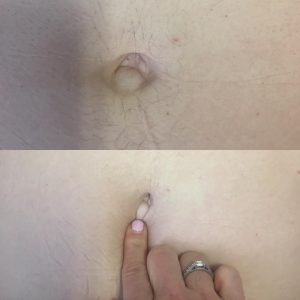Rectus Abdominus Diastasis (RAD) is a separation of the linea alba, greater than 2 centimeters is considered abnormal. The linea alba is a thick connective tissue that connects the two rectus abdominus muscles together, down the center. With RAD a separation of the abdominal wall occurs because of stretch or sealing of the linea alba. Diastasis rectus abdominus is commonly seen in women during and after pregnancy, in overly fit men and women who focus on excessive abdominal strengthening, and in adults who are overweight with abdominal central obesity.

In this image we are evaluating a 40 year old male who presented with complaints of low back pain and a history of a mild bulging lumbar disc, diagnose by MRI. Although he reported using a trainer weekly and performing core exercises, he has low abdominal tone, distention, and mild central belly fat. During the evaluation we also noted that his umbilicus (or belly button) had a “loose” appearance. We questioned him as to if he’s noticed a recent change. After he looked at it in the mirror he realized that this was a definite change. This is likely an umbilical hernia. There appears to be a soft bulge/swelling near the umbilicus (navel), and they usually range from 1-5 centimeters in diameter. Umbilical hernias can result from heavy lifting, from being overweight, or from excessive coughing. He is being referred to a hernia surgeon for consultation, yet at present he is asymptomatic of pain in his abdomen.
Our patient also tested positive for a 1 finger Diastasis Recti upon curl up testing. This is when the patient lies supine and gently lifts their head off the table. The clinician measures the inter-recti distance via fingers width. This is standard for measuring. Calipers can also be used. Because RAD produces deterioration in the functions of the abdominal wall with associated muscular imbalance and can be a factor in chronic back pain this must be addressed during his physical therapy treatment with us. Other findings during the consultation included core weakness, constipation, impaired lifting strategies (he has young children), misaligned L5, sacral torsion, pelvic upslip, flattened foot arches, impaired breathing pattern, and sciatic neural tension. All of these issues will be addressed in a comprehensive approach to his care.
Diastasis Rectus Abdominus in Men with Concurrent Umbilical Hernia
Posted by Pamela Morrison on May 31, 2017 in Uncategorized



